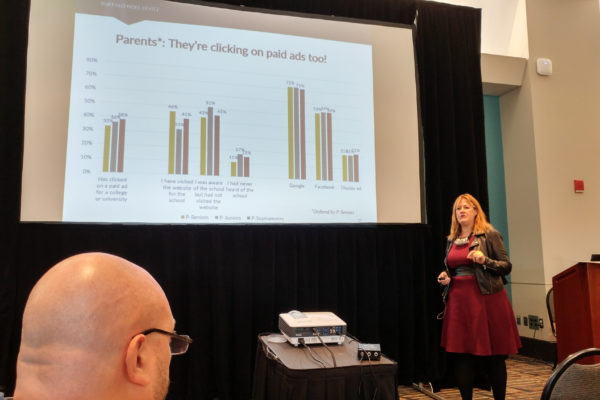College and universities’ website, email, and social media strategies dominated discussion Tuesday afternoon at the HighEdWeb17 session titled, “E-Expectations 2017: How Online Expectations Change for Today’s Prospective Students and Parents.”
Presenters Stephanie Geyer, Gil Rogers, and Lance Merker walked attendees through highlights of the 2017 Ruffalo Noel Levitz E-Expectations report. The survey included the opinions of more than 4,200 high school students and more than 2,100 parents.
Geyer drew a few gasps and laughs from attendees with her first slide sharing that 62 percent of parents reported finishing their child’s college applications. Fewer than a third of seniors reported that their parents had completed an application.
For students, the data showed the most popular sources of information about a college are websites, emails, cost-of-attendance calculators, and printed brochure. Parents ranked cost-of-attendance calculators second.
Roughly a third of students reported using college planning sites such as Collegeboard, MyCollegeOptions, and FastWeb, Rogers said. He said it served as a reminder that students are evaluating schools on platforms that schools themselves do not control.
Once a student or parent visits a school’s website, what do they do? Rogers said more than half filled out a form requesting more information—a group that included many sophomores.
“Schools should be thinking of the communications strategies for reaching sophomores and their parents,” Rogers said. “They’re filling out as many if not more forms than college seniors.”

Once a request has been made, about three in every four students believed the best response would be an email with links for next steps. The data showed three-fourths of parents also wanted an email—only they prefered to hear from an admissions counselor.
Rogers said the results of the survey underscored the importance of strong email communications. It was rated one of the most influential resources for students.
“After search engines, emails with links are the leading method for finding information,” Rogers said. “Emails need to be mobile-friendly, and subject lines matter.”
Text messages are an underused opportunity to reach students, Rogers said. Seventy percent of students reported they are willing to receive reminders via text, but that only 20 percent have.
Rogers shared a few key implications of the report:
- Review representation on college planning sites and update it if necessary
- Forms should be the start of the relationship
- Email remains a critical tool
- Consider texting strategies, especially for students deeper in the application process
The 2017 E-Expectations report also highlighted social media’s continued importance. But students and parents’ priorities landed on different ends of the spectrum. While students wanted to learn about a college’s social aspects, parents wanted information about cost and application deadlines.
The social network dictates which content is most appropriate, Rogers said. The report found that among social networks, about 40 percent of students considered Facebook to be the best for learning about a college or program. Snapchat was considered the least effective; fewer than 15 percent considered it the best social network to learn about an institution.
Geyer, Rogers, and Merker shared important implications and considerations for social media:
- Distinguish between “daily use” and “good for college information”
- Focus on visual and mobile platforms first
- Intergrate social channels into your traditional outreach
- Focus on basics before “going live”
- Leverage digital marketing investments wisely
When it comes to paid interactive marketing, Geyer shared that the report showed many students—more than 60 percent of sophomores alone—did click on ads. Google Ads and Facebook proved to be reliable drivers of website traffic.

But Geyer did encourage attendees to keep a few things in mind:
- Paid ads are an asset to reach prospective students and parents, especially sophomores
- Most clickers had some awareness of the school; use ads to reach those who know about you but are yet to engage
- Use curated landing pages as ad destinations, not generic homepages
Websites also need to be mobile-friendly, Merker said. The E-Expectations report showed 85 percent of high school seniors have a smartphone, and more than half use it as their primary device for web browsing. Many also used their phones to complete request-for-information forms.
Merker warned the impact of a bad website experience can be significant. Ten percent of students claimed they would remove a school from their list of potential places to apply if they disliked the website.
Students who responded to the survey also ranked images of campus life in order of most appealing to least appealing. Aerial photography and pictures from the student’s perspective performed best. Staged or posed pictures performed worst.
For websites, Geyer, Rogers, and Merker listed the following implications:
- Make sure a website is mobile-friendly, including forms
- Optimize major/program pages for search engines
- Re-evaluate website photography


